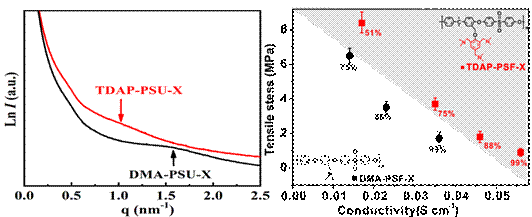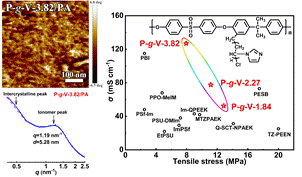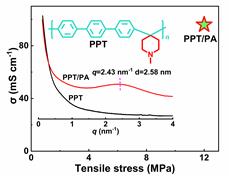| Modulation of high temperature polymer electrolyte membrane |
| From: PublishDate:2020-07-31 Hits: |
Phosphoric acid-doped polymer electrolyte membrane is considered as the most promise high temperature polymer electrolyte membrane (HT-PEM) due to high proton conductivity, good chemical and thermodynamic stability under high temperature, low relative humidity or anhydrous conditions. However, for such kind of HT-PEM, there is a trade-off relation between the mechanical properties and proton transfer properties. The strategy that the design of micro-phase separation structure adjusts performance has solved successfully the balance between the mechanical properties and proton conductivity of low-temperature polymer electrolyte membranes. However, it has not been applied in the field of the design and research of HT-PEM materials. Beijing Key Laboratory of Bio-inspired Energy Materials and Devices (Beihang University) firstly proposed the design concept of micro-phase separation structure of HT-PEM, and conducted a comprehensive and systematic deep study on the micro-phase separation design and performance modulation of HT-PEM. Related research results were published in the Journal of Membrane Science in volumes 572 and 592 in 2019 and in the Journal of Power Sources in volume 443 in 2019. This team grafted the nitrogen-containing functional groups (such as 2,4,6-tri(dimethylaminomethyl)-phenol, vinylimidazole, etc.) as phosphoric acid anchoring sites method on Polysulfone molecular main chain via the Friedel-Grafts reaction and the atom transfer radical polymerization, obtaining a series of polymer materials with different side chain structures. Research results showed that the side chain structure is benefit for the formation of micro-phase separation structure of phosphoric acid-doped HT-PEM. The nitrogen-containing functional groups on the side chain structure could absorb phosphoric acid to form hydrophilic ion clusters, and the hydrophobic main chain formed hydrophobic domain. Therefore, the micro-phase separation structure exists in membrane. Such structure on the one hand provides a fast proton transport channel, on the other hand, the accumulation of phosphoric acid in the hydrophilic area reduces the plasticizing effect of phosphoric acid molecules on the polymer backbone, retaining the mechanical properties of the membranes. In addition, the team continued to design and develop the main chain type micro-phase separation poly(arylene piperidine)s membrane material. They use 1W2A-SAXS station of Beijing Synchrotron Radiation Facility to measure the optimized membrane material ion cluster size of 2.58 nm, the proton conductivity was as high as 0.096 S cm-1, and the tensile strength reached 12 MPa, which achieves a win-win situation between proton transfer performance and mechanical performance. The HT-PEM fuel cell based on PPT/PA membrane has a maximum output power density of 1.2 W cm-2 at 180 oC and exhibits excellent stability during 1600 h. This work indicated PPT were a promising PA doping polymer matrix for HT-PEM fuel cells application.
Article: 1.Jujia Zhang, Jin Zhang, Huijuan Bai, Qinglong Tan, Haining Wang, Baoshan He, Yan Xiang, Shanfu Lu. A new high temperature polymer electrolyte membrane based on trifunctional group grafted polysulfone for fuel cell application. Journal of Membrane Science 572 (2019), 496–503. 2.Huijuan Bai, Haining Wang, Jin Zhang, Jujia Zhang, Shanfu Lu, Yan Xiang. High temperature polymer electrolyte membrane achieved by grafting poly (1-vinylimidazole) on polysulfone for fuel cells application. Journal of Membrane Science 592 (2019) 117395. 3.Huijuan Bai,a Hanqing Peng,b Yan Xiang,a Jin Zhang,a Haining Wang,a Shanfu Lu, Lin Zhuang. Poly(arylene piperidine)s w.ith phosphoric acid doping as high temperature polymer electrolyte membrane for durable, high-performance fuel cells. Journal of Power Sources 443 (2019) 227219. |
|
|
| Chinese
- Metal-free efficient photocatalyst for stable visible water splitting——Top ten major scientific progresses in China in 2015
- The nano-resolution imaging platform was awarded the first rate prize of Beijing Science and Technology in 2014
- Beamline 1W1 of BSRF started to runoperate in the couplingparasitic mode of BEPCII
- Synthesis of High Performance Polymer Materials for Field Effect-Transistors
- Surfactant molecular aggregates in green solvents
- GIXRD has played an important role in the characterization of organic thin-film transistors
Science Highlights
Home /
Copyright © 2011 - 2012 Beijing Synchrotron Radiation Facility




